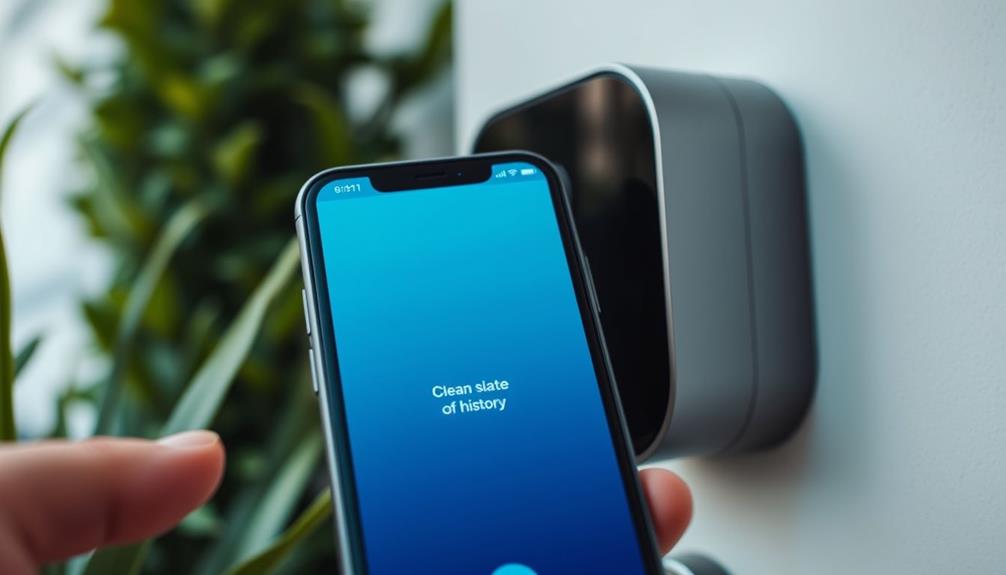To attach your Ring Doorbell, first charge its battery using the included USB cable. Then, mark the screw holes for the mounting bracket about 4 feet high on your wall. Secure the bracket with screws or wall anchors. Next, align the Ring Doorbell with the bracket until it clicks into place. If you're connecting to existing doorbell wires, loosen the screws on the back, wrap the wires, and secure them gently. Finally, restore power at the circuit breaker. With everything set, open the Ring app to configure settings and enhance your security further.
Key Takeaways
- Charge the Ring Doorbell battery fully using the provided USB cable before installation.
- Secure the mounting bracket to the wall at approximately 1.2 meters (4 feet) high with screws or wall anchors.
- Align the Ring Doorbell with the mounting plate and press until it clicks into place.
- For wired models, connect existing doorbell wires to the back, ensuring no contact between them.
Overview of Ring Doorbell Models
When choosing a Ring doorbell, you'll find several models, each designed to meet different needs and installation preferences.
The Ring Video Doorbell (2nd Gen) is a popular battery-operated model, perfect for renters or anyone who wants a quick installation without the hassle of hardwiring. It allows you to monitor your home remotely through the Ring app, making it a convenient choice. Additionally, the presence of security systems, such as Ring doorbells, can greatly deter potential burglars, providing peace of mind to homeowners increased safety and peace of mind.
If you're looking for advanced features, the Ring Video Doorbell Pro requires hardwiring to connect to your existing doorbell system. This model offers customizable motion zones, which lets you tailor alerts to specific areas, enhancing your security. You'll also enjoy superior video quality, ensuring you capture every detail.
For those seeking a professional-grade option, the Ring Video Doorbell Elite is your best bet. It features Power over Ethernet (PoE) for continuous power and high-definition video capabilities, making it ideal for thorough home monitoring.
All Ring doorbells integrate seamlessly with the Ring app, providing remote monitoring and access to recorded events with a subscription plan, ensuring you're always connected to your home security.
Required Tools and Materials
To successfully install your Ring doorbell, you'll need a few specific tools and materials at hand. Gathering these essentials will make your installation process smooth and efficient. It's also helpful to reflect on the significance of a clean and organized workspace, as this can enhance your overall efficiency during installation. Here's what you should have ready:
- Screwdriver – This will help you secure the mounting bracket and fasten the screws.
- Power drill and masonry drill bit – If you're installing on hard surfaces like brick or stucco, you'll need these to create holes for the wall anchors.
- Charging cord – This is crucial for powering up your Ring doorbell before installation.
You'll also need the screws included in your Ring Doorbell package and wall anchors if you're drilling into a sturdy surface.
Don't forget to download the Ring app on your smartphone, as it'll guide you through the setup and customization of your doorbell's features. Having a pencil or small level on hand can help you mark screw holes accurately and guarantee the mounting bracket is aligned properly.
If you're replacing an old doorbell, a box cutter or flathead screwdriver may be needed to remove it first.
With these tools and materials, you're ready to get started! For additional efficiency tips, reflect on checking out essential items for home cleaning to keep your workspace tidy during installation.
Safety Precautions Before Installation

Before starting the installation, make certain to disconnect power at the circuit breaker to prevent any electrical hazards. Safety precautions are vital when working with electrical wiring. Always handle wires with caution to avoid any damage or accidents. It's also important to consult local laws and building codes concerning electrical work, making sure that your installation is compliant.
If you're unsure about any aspect of the installation, don't hesitate to hire a qualified electrician. They can guarantee the installation is safe and up to code. Additionally, be certain that your Ring doorbell is compatible with your existing doorbell system to avoid any issues during installation.
Here's a quick reference table for safety precautions:
| Safety Tips | Action Required | Importance |
|---|---|---|
| Disconnect power | Turn off at the circuit breaker | Prevents electrical hazards |
| Handle wiring with caution | Avoid damaging any wires | Guarantees safety during installation |
| Consult local laws | Research building codes | Ensures compliance |
| Hire a qualified electrician | Consider professional help | Assures a safe installation |
| Check compatibility | Verify with existing system | Prevents installation issues |
Following these precautions will help you install your Ring doorbell safely and effectively.
Step-by-Step Installation Process
Having guaranteed your safety precautions are in place, let's move on to the step-by-step installation process of your Ring Doorbell. Proper installation is essential for ensuring peak performance and security, as effective clustering improves user experience and content discoverability.
- Charge the Battery: First, charge the built-in battery of your Ring Doorbell using the provided USB cable until the blue light shows it's fully charged. This usually takes about 4 to 6 hours.
- Mounting the Bracket: Use a level tool to mark screw holes for the mounting bracket at around 1.2 meters (4 feet) from the ground. Secure the bracket to the wall with the included screws. If you're mounting it on hard surfaces like brick, drill pilot holes and use wall anchors for stability.
- Attach the Doorbell: Now, align your Ring Doorbell with the mounting plate and press down firmly until it clicks into place. Finally, restore power at the circuit breaker to activate your device.
Don't forget to download the Ring app to create your account and sync the doorbell by scanning the unique QR code. With these steps, you're well on your way to enjoying the benefits of your new Ring Doorbell.
Connecting to Existing Doorbell Wires

Connecting your Ring Doorbell to existing doorbell wires enhances its functionality and guarantees consistent power supply. First, check that your system operates within the 8-24 VAC compatibility range to prevent damage. Regular maintenance of your electrical systems can help identify potential issues before they escalate, ensuring a safe installation HVAC maintenance importance.
Begin by loosening the screws on the back of the Ring Doorbell. Then, wrap the existing wires around the screws, ensuring they don't touch each other to prevent short circuits. The order of connecting to the screws doesn't matter; you can attach either wire to either screw. Once the wires are secured, carefully tuck them back into the wall and position the Ring Doorbell over the mounting bracket. Tighten the screws to secure the unit firmly in place. For more detailed guidance on how to install Ring Doorbell devices, consult the instruction manual or visit the Ring website for step-by-step tutorials.
Once you've wrapped the wires securely, tighten the screws gently to secure the connections without damaging the wires. If you have a digital chime, don't forget to attach the included diode to help with compatibility.
After securing the wires, carefully mount the doorbell onto the bracket provided. Finally, restore power at the circuit breaker to activate your new doorbell. With everything connected properly, your Ring Doorbell should be ready to enhance your home security and provide you with peace of mind.
Configuring Settings in the App
Now that your Ring Doorbell is installed, it's time to configure the settings in the app.
Customization not only enhances your experience but also guarantees that you receive relevant alerts, which is essential for balancing innovation and privacy rights.
You can customize your notification preferences and set up motion detection zones to tailor your alerts exactly how you want them.
Let's explore how to optimize these features for your needs.
Notification Preferences Setup
To customize your Ring Doorbell's notification preferences, open the Ring app and head to the "Device Settings" section. Here, you can tailor your alerts to enhance your security experience, which is especially important given the increasing concerns about credit card security risks. Follow these steps to set up your preferences:
- Notification Settings: Choose to enable or disable alerts for motion detection and doorbell presses. This allows you to decide what notifications are important to you.
- Motion Sensitivity: Adjust the motion sensitivity levels to filter out unnecessary alerts. You'll only receive notifications for significant movements, keeping your notifications relevant.
- Chirp Tones: Enable Chirp Tones to customize the sound of your notifications. This way, you can easily distinguish Ring alerts from other notifications on your device.
Additionally, consider setting up Motion Zones to define specific areas for alerts. This will enhance the focus of your notifications, ensuring you're only notified about movements that matter.
Motion Zone Configuration
Configuring motion zones in the Ring app lets you tailor your alerts to focus on the areas that matter most. To start, open the Ring app and select your Ring Doorbell. Tap on "Motion Settings" to access the motion zone configuration. Here, you can create custom motion zones by dragging the corners of the outlined area on the live view screen, allowing you to include or exclude specific regions where you want to detect motion.
Additionally, you can adjust the sensitivity of motion detection from low to high. This feature helps reduce false alerts from passing cars or pets, making your alerts more relevant. If you want even more control, enable "Motion Scheduling" to set specific times when detection is active or inactive based on your daily routines.
After configuring your motion zones, it's essential to use the "Test Motion Zones" feature in the app. This allows you to verify that your settings are working as desired before finalizing the configuration.
With these adjustments, you'll enhance your Ring experience, making it more suited to your needs.
Utilizing features found in air purifier usage can further enhance your home environment by reducing indoor pollutants.
Troubleshooting Common Issues

If you're facing issues with your Ring Doorbell, you're not alone.
Common problems like video quality and connectivity can be easily fixed with a few simple adjustments.
Additionally, understanding the importance of secure communication channels can help in troubleshooting connectivity issues effectively, as cybersecurity measures can impact device performance.
Let's look at how you can troubleshoot these issues effectively.
Video Quality Problems
When you notice video quality issues with your Ring Doorbell, check its distance from your WiFi router, as being no more than 30 feet away can greatly improve performance.
Additionally, understanding how to optimize your device settings can enhance overall user experience, similar to how music production basics can impact sound quality.
Here are three steps you can take to enhance video quality:
- Use a Ring Chime Pro: This device helps extend your WiFi coverage, reducing connectivity issues that can lead to poor video quality.
- Inspect the Mounting Angle: Confirm your Ring Doorbell is mounted correctly. A misaligned angle can hinder video capture and clarity, so adjust it if necessary.
- Optimize Ring App Settings: Make certain your Ring app is set up for high-definition video streaming. Lower settings can result in diminished video quality.
Lastly, don't forget to regularly check and optimize your router settings. Adjusting channel selection and bandwidth allocation can help minimize interference from other devices.
Connectivity and Power Issues
Troubleshooting connectivity and power issues with your Ring Doorbell is fundamental for guaranteeing it functions properly and delivers reliable performance.
First, check that your doorbell is connected to a compatible power source, specifically an 8-24 VAC transformer. If your doorbell isn't powering on, confirm that power has been restored at the circuit breaker after installation and that all wires are securely connected. Additionally, just like how maintaining consistent pressure is essential for ideal espresso extraction, confirming stable power supply is crucial for your doorbell's performance.
Next, if you're facing connectivity issues, consider relocating your router closer to the doorbell or using a Ring Chime Pro to enhance WiFi coverage. The Ring app is a valuable tool for troubleshooting; it allows you to adjust your settings and confirm your device has a secure connection to your home WiFi network.
Additionally, verify the battery status. A fully charged battery will show a solid green LED light, while a red light indicates it's still charging. Keeping these factors in mind will help you address any power or connectivity issues, confirming your Ring Doorbell remains functional and effective in providing security for your home.
Additional Features and Accessories
Enhance your Ring Doorbell experience with a variety of accessories and features designed for peak security and convenience. Here are three essential items you might consider:
- Ring Protect Subscriptions: For just $4/month, you can enjoy benefits like video recording and cloud storage, allowing you to access recorded events for up to 60 days. This adds an extra layer of security to your home.
- Chime: This handy accessory provides audible alerts whenever someone rings your doorbell. It guarantees you never miss a visitor, even if you're in a different room.
- Wedge Kit and Solar Charger: The Wedge Kit allows for angled installations, improving visibility and coverage, while the Solar Charger reduces battery recharging frequency. This accessory promotes sustainable power solutions for your Ring Doorbell.
With the Ring app, you can customize features like motion detection zones to suit your preferences. By integrating these accessories, you'll enhance your Ring Doorbell's functionality and guarantee peak performance for your home security needs.
Frequently Asked Questions
What Is the Best Way to Stick Ring Doorbell?
The best way to stick your Ring Doorbell is to use the mounting bracket included in the package.
First, find a suitable location at about 1.2 meters (4 feet) high.
Make sure the bracket is level and mark the screw holes.
If you're mounting on brick or concrete, drill pilot holes and use wall anchors.
How to Attach a Ring Doorbell to a Door?
Did you know that homes with video doorbells see a 55% increase in package security?
To attach your Ring Doorbell to a door, start by charging the built-in battery fully.
Then, use the mounting bracket to mark screw holes about four feet high.
Secure the bracket and connect any necessary wires.
Finally, attach the doorbell, restore power, and test it to guarantee everything works smoothly.
Don't forget to secure the faceplate!
Is There a Way to Install Ring Doorbell Without Drilling?
Yes, you can install a Ring Doorbell without drilling!
Consider using heavy-duty adhesive tape for smooth surfaces or a suction mount for a temporary setup.
If you're renting or want a no-drill option, try a freestanding post.
Magnetic mounts are another alternative but verify they're compatible with your doorbell.
Just make certain whatever method you choose can support the weight and withstand outdoor conditions for reliable performance.
How Do You Attach a Ring Doorbell Without a Screw?
Imagine your doorbell springing to life without a single screw in sight. To attach a Ring Doorbell without screws, you've got options!
Use adhesive mounts designed for outdoor use; they'll cling like a loyal friend when you clean the surface first.
Check the weight limit to guarantee it can handle your model, and if that doesn't work, consider wall anchors as a backup.
Your doorbell can still shine without any drilling!
Conclusion
To sum up, installing your Ring Doorbell can be a straightforward process when you follow the right steps.
Whether you connect it to existing doorbell wires or set it up wirelessly, you'll enhance your home's security.
Remember, a well-placed Ring Doorbell not only protects your property but also gives you peace of mind.
With its additional features and accessories, you can customize your setup to fit your needs, making it a valuable investment in your safety.









